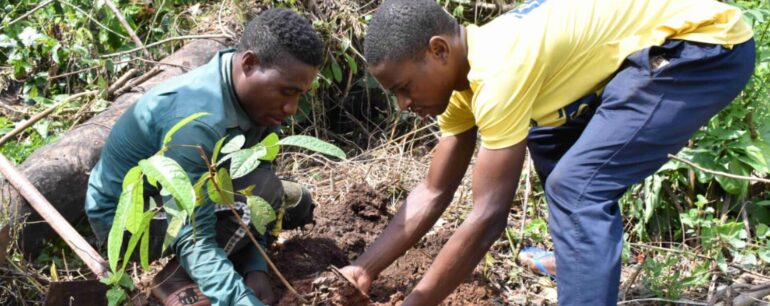Omanyano ovanhu koikundaneki yomalungula kashili paveta, Commisiner Sakaria takunghilile
Veronika Haulenga
Omanyano ovanhu koikundaneki yomalungula kashili paveta, Commisiner Sakaria takunghilile
Veronika Haulenga
Listeners:
Top listeners:
-
play_arrow
Omanyano ovanhu koikundaneki yomalungula kashili paveta, Commisiner Sakaria takunghilile Veronika Haulenga
Reforestation to capture carbon could be done much more cheaply, study says


By Liz Kimbrough, via Mongabay
Trees are allies in the struggle against climate change, and regrowing forests to capture carbon may be cheaper than we thought. According to new research published in Nature Climate Change, a strategic mix of natural regrowth and tree planting could be the most cost-effective way to capture carbon.
Researchers analyzed reforestation projects in 138 low- and middle-income countries to compare the costs of different reforestation approaches. They found it’s possible to remove 10 times more carbon at $20 per metric ton, and almost three times more at $50, compared to what the Intergovernmental Panel on Climate Change (IPCC) had previously estimated.
Neither natural regeneration nor tree planting consistently outperforms the other. Instead, the most cost-effective method varies depending on local conditions. Natural regeneration, which involves letting forests regrow on their own, is cheaper in about 46% of suitable areas. Tree planting, on the other hand, is more cost-effective in 54% of areas.
“Natural regeneration is more cost-effective in areas where tree planting is expensive, regrowing forests accumulate carbon more quickly, or timber infrastructure is distant,” said lead author Jonah Busch, who conducted the study while working for Conservation International. “On the other hand, plantations outperform in areas far from natural seed sources, or where more of the carbon from harvested wood is stored in long-lasting products.”
The research team estimates that by using the cheapest method in each location, we could remove a staggering 31.4 billion metric tons of carbon dioxide from the atmosphere over 30 years, at a cost of less than $50 per metric ton. This is about 40% more carbon removal than if only one method was used universally.
“It’s exciting that the opportunity for low-cost reforestation appears much more plentiful than previously thought; this suggests reforestation projects are worth a second look by communities that might have prejudged them to be cost prohibitive,” said Busch. “While reforestation can’t be the only solution to climate change, our findings suggest it should be a bigger piece of the puzzle than previously thought.”
To reach these conclusions, the research team gathered data from hundreds of reforestation projects and used machine-learning techniques to map costs across different areas at a 1-kilometer (0.6-mile) resolution. This detailed approach allowed them to consider crucial factors such as tree growth rates and potential species in different regions.

Ecologist Robin Chazdon, who wasn’t involved in the research, praised the comprehensive approach but highlighted important considerations beyond cost-effectiveness.
“These eye-opening findings add nuance and complexity to our understanding of the net costs of carbon storage for naturally regenerating forests and monoculture plantations,” Chazdon said. However, she emphasized that “the relative costs of carbon storage should not be the only factor to consider regarding spatial planning of reforestation.”
Chazdon pointed out some of the ecological trade-offs involved in different reforestation methods. Monoculture tree plantations, while potentially cost-effective in certain areas, often create excessive water demand and provide poor opportunities for native biodiversity conservation. In contrast, naturally regenerating forests typically offer a wider range of ecosystem services and better support local biodiversity.
“Ultimately, these environmental costs and benefits — which can be difficult to monetize — need to be incorporated in decisions regarding how and where to grow plantations or foster natural regeneration,” Chazdon said.
The study’s authors acknowledge these limitations and suggest several directions for future research. They propose extending the analysis to high-income countries and exploring other forms of reforestation, such as agroforestry or planting patches of trees and allowing the rest of an area to regrow naturally.
Additionally, the researchers emphasize the need to integrate their findings on cost-effectiveness with data on biodiversity, livelihoods and other societal needs to guide reforestation efforts in different contexts.
While the study’s findings are promising, the researchers caution that reforestation alone won’t solve the climate crisis. Even at its maximum potential, reforestation would only remove as much carbon dioxide in 30 years as eight months of current global emissions.
Reforestation is very important, but it won’t solve climate change on its own, Busch said. Ultimately, “we still need to reduce emissions from fossil fuels.”
Banner image of two men planting trees in the Yokadouma Council Forest, Cameroon. Image courtesy WWF.
Liz Kimbrough is a staff writer for Mongabay and holds a Ph.D. in ecology and evolutionary biology from Tulane University, where she studied the microbiomes of trees. View more of her reporting here.
Written by: Contributed
biodiversity Carbon Capture Carbon Dioxide Climate Change Conservation International cost-effectiveness ecological trade-offs ecosystem services IPCC Jonah Busch Machine Learning monoculture plantations natural regeneration Nature Climate Change reforestation Robin Chazdon tree planting
Similar posts
Most popular

Omuhwahwameki Michael okuunganeka oshikonga shoku patitha oostola dho Rani moshilongo ashihe.

Justice Served: Jandre Dippenaar Found Guilty of Six Murders in Swakopmund Court

The Alexforbes Lead Story – 12 December

Obituary: Hage G Geingob 3 August 1941 – 4 February 2024

Brazilian Tourist Arrested for Culpable Homicide in Fatal Otavi Collision
Copyright 2024 Future Media (Pty) Ltd | Website by Digital Platforms
Tel: +264 83 000 1000 | Email: news@futuremedia.com.na







